![]()
The Murray (CM2) Meteorite
Evidence indicates that the Murray meteorite predates the solar system.
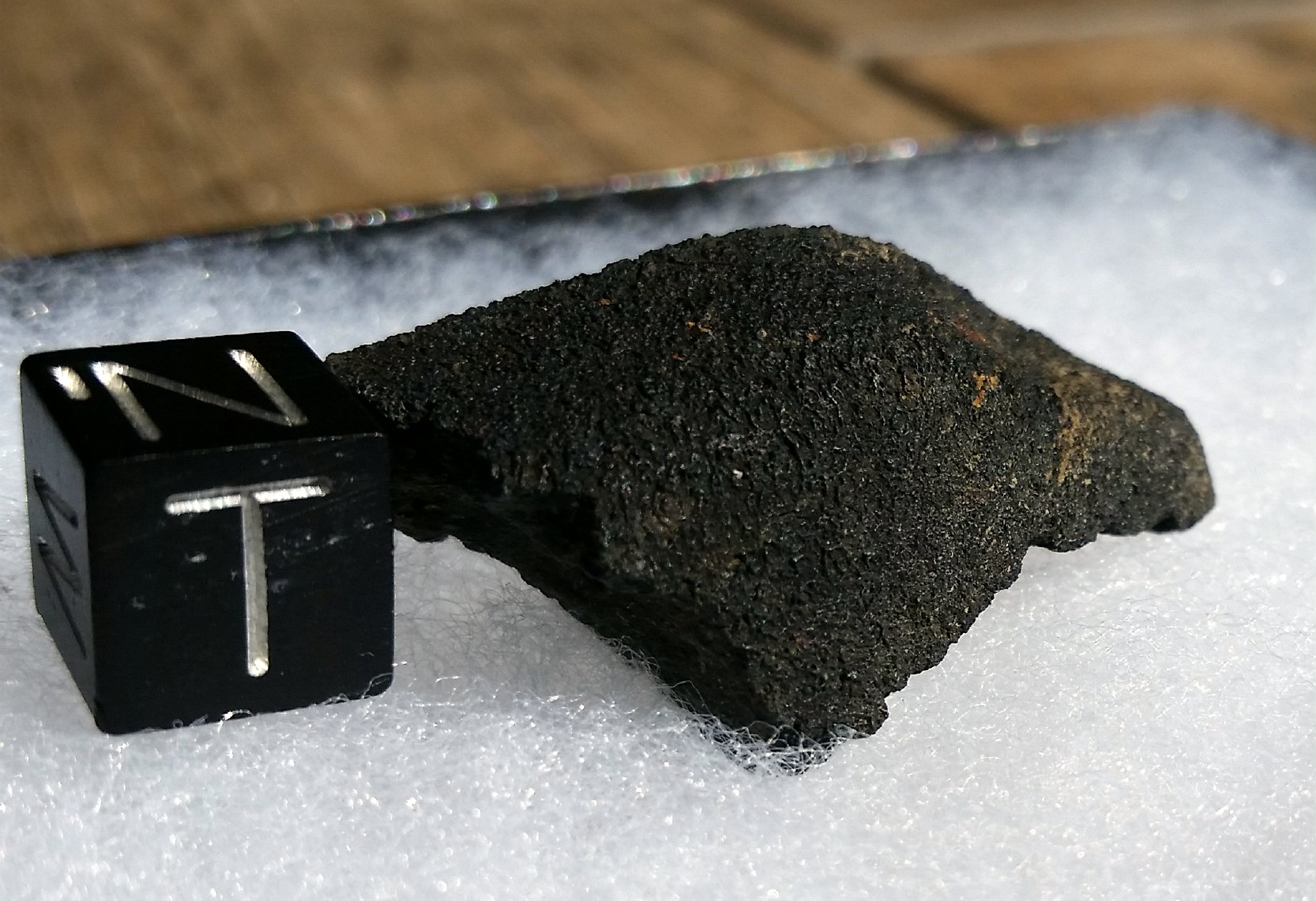
So, with my interest sufficiently piqued, I decided to pull-out for closer-examination the CM2 specimens that were in my collection. I chose to start with my endcut of Murray, which I obtained through a trade with researchers who were more keenly interested, at that time, in studying some specimens of my Los Angeles Mars-rock diabasic shergottite.
The first thing I noticed was a very fresh fusion-crust. It was fresh, but also uniquely different-looking. Instead of being "shiny-black", the fusion-crust was comprised of many small, densely-packed flow-lines that had a flat-black matte-like sheen. I assumed that this meant that the fusion-crust was primarily composed of carbon, and probably deficient in calcium, iron and silica. So, in order to confirm this assumption, I went to the MBD (Meteoritical Bulletin Database), but there was very little information in the way of mineral composition. And clicking on the button to search "NASA-ADS" resulted in nearly all of the 70 references being related to the geology of the "Murray Formation" in the Gale Crater on Mars!
So, I embarked on an Internet search to see how much information that I could find on the Murray meteorite, with the intention to compile all of the results in one place -- this article -- just for the convenience and ease in getting back to this data without having to redo all the effort in tracking down all of these references.
And, yes, the fusion-crust is a melted version of the meteorite's interior composition, which is primarily a matrix of graphitic carbon with a wide range of inclusions of refractory residue and small chondrules composed mostly of olivine.
Below is another view of the fusion-crust on my specimen of the Murray (CM2) meteorite.
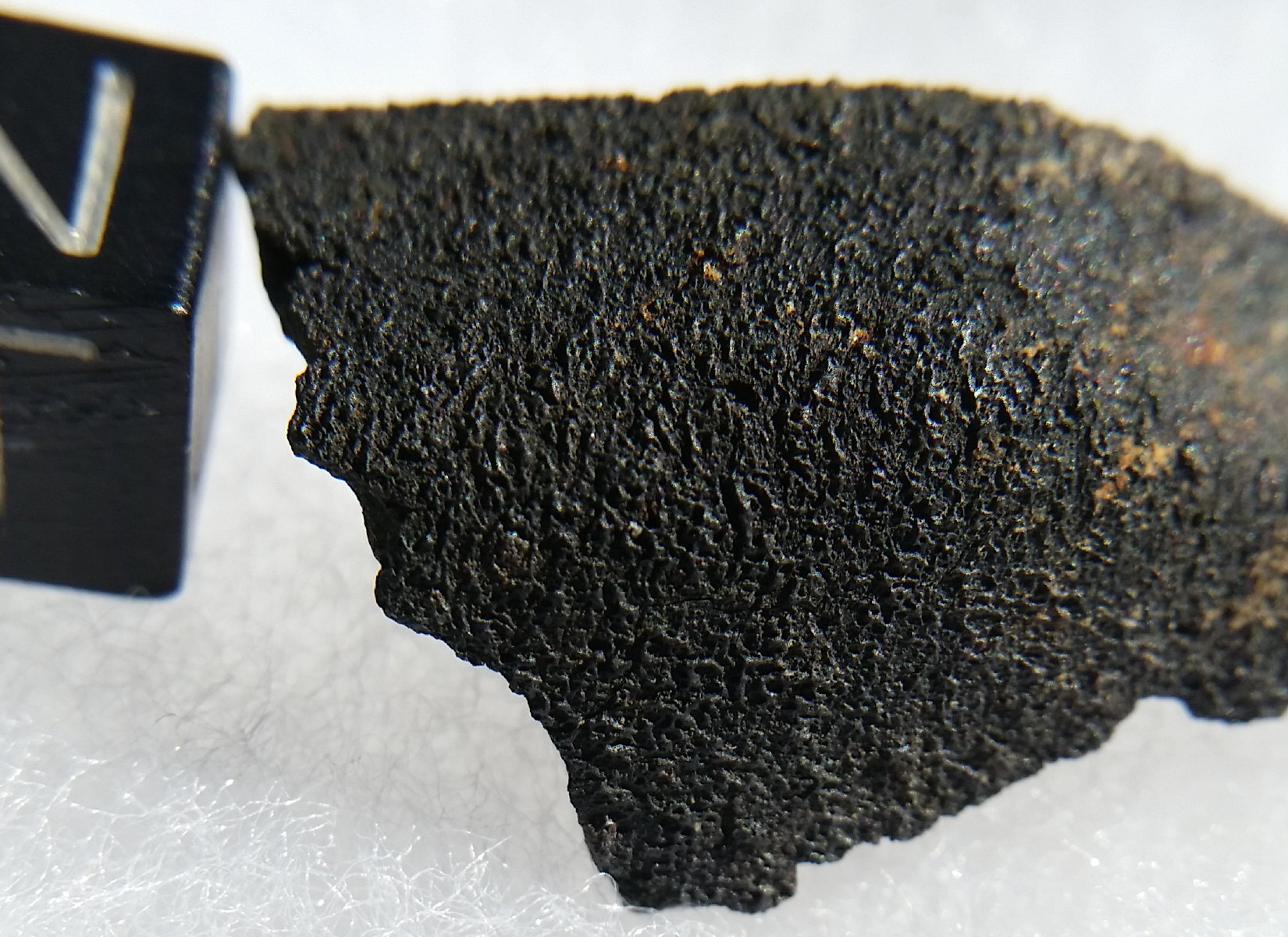
Above is another view of the fusion-crust on my specimen of the Murray (CM2) meteorite.
Below is a close-up shot of the same fusion-crust depicted in the above image.
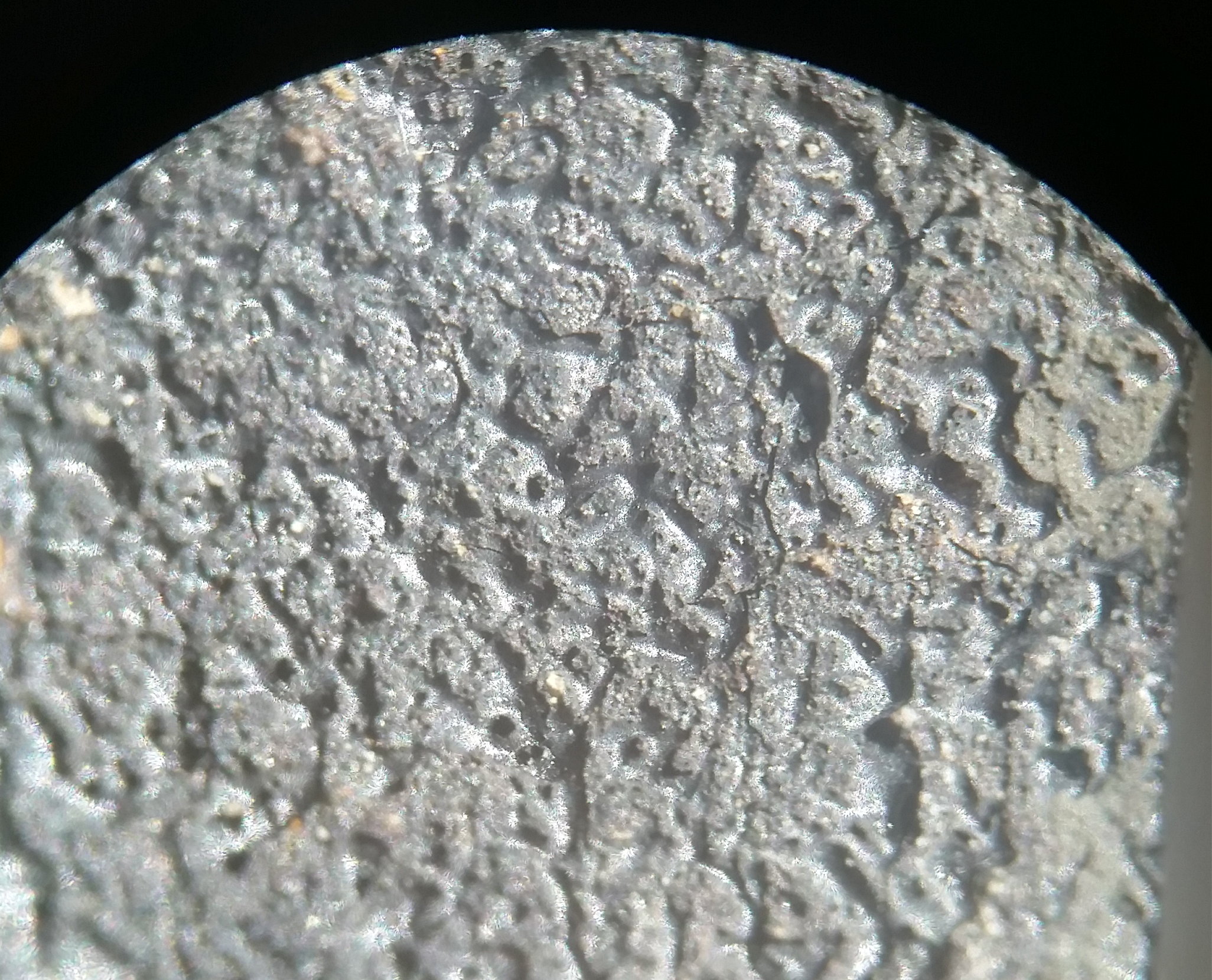
Above is an image taken through the X10 power eye-piece on my microscope of the fusion-crust on my specimen of the Murray (CM2) meteorite.
Below is an image taken with my microscope (X10 power) of the cut-surface on my specimen of the Murray (CM2) meteorite.
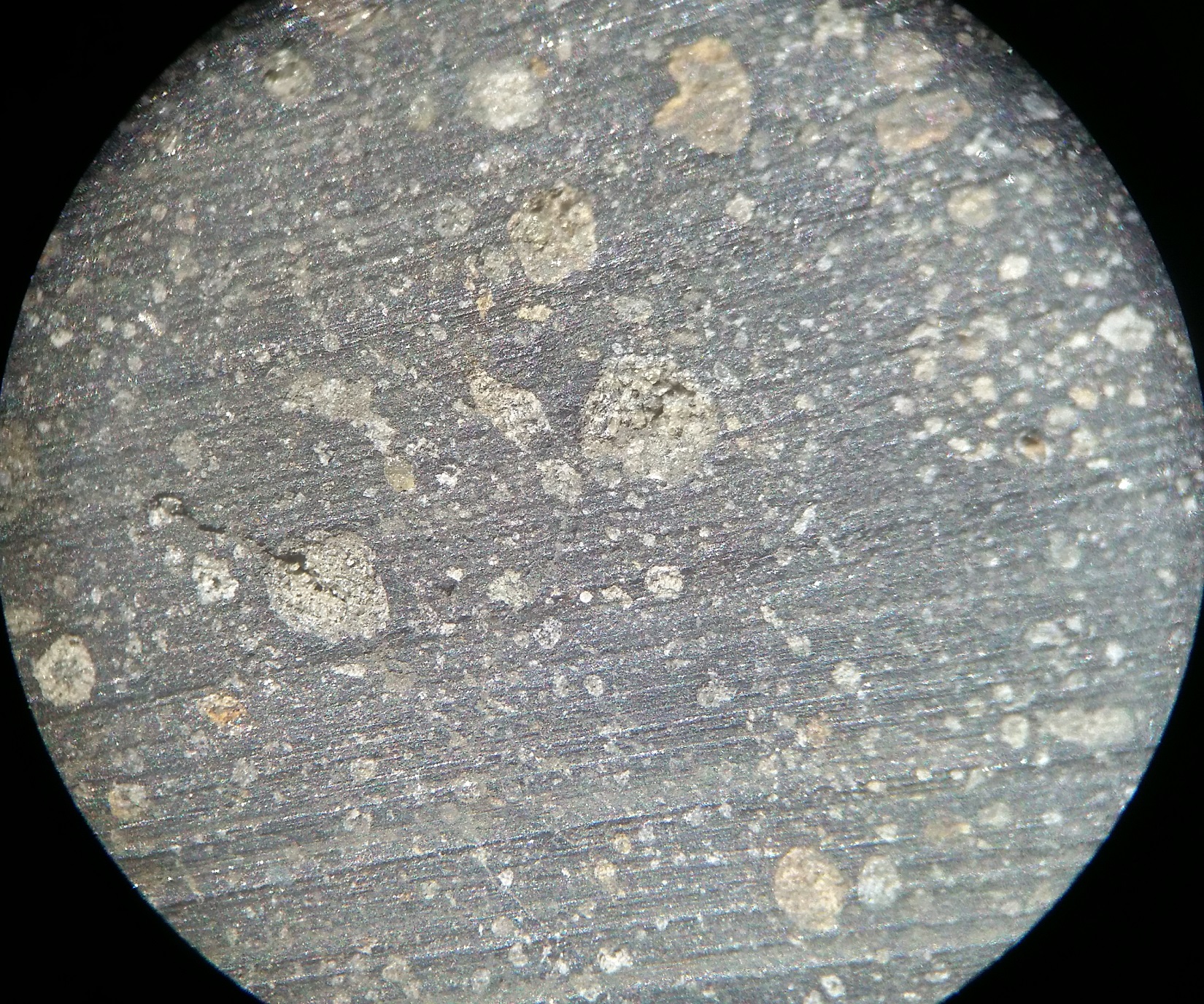
Above is an image (X10 magnification) of the cut-surface on my endcut specimen of Murray (CM2), as evidenced by the saw-marks.
This is the same (as-is) condition how I received this endcut from the research institution.
And likewise, as with all of the cut specimens in my collection, I forego polishing in order
to avoid introducing further contamination in case samples are requested for study by researchers.
Below is another view of the fusion-crust on my specimen of the Murray (CM2) meteorite.
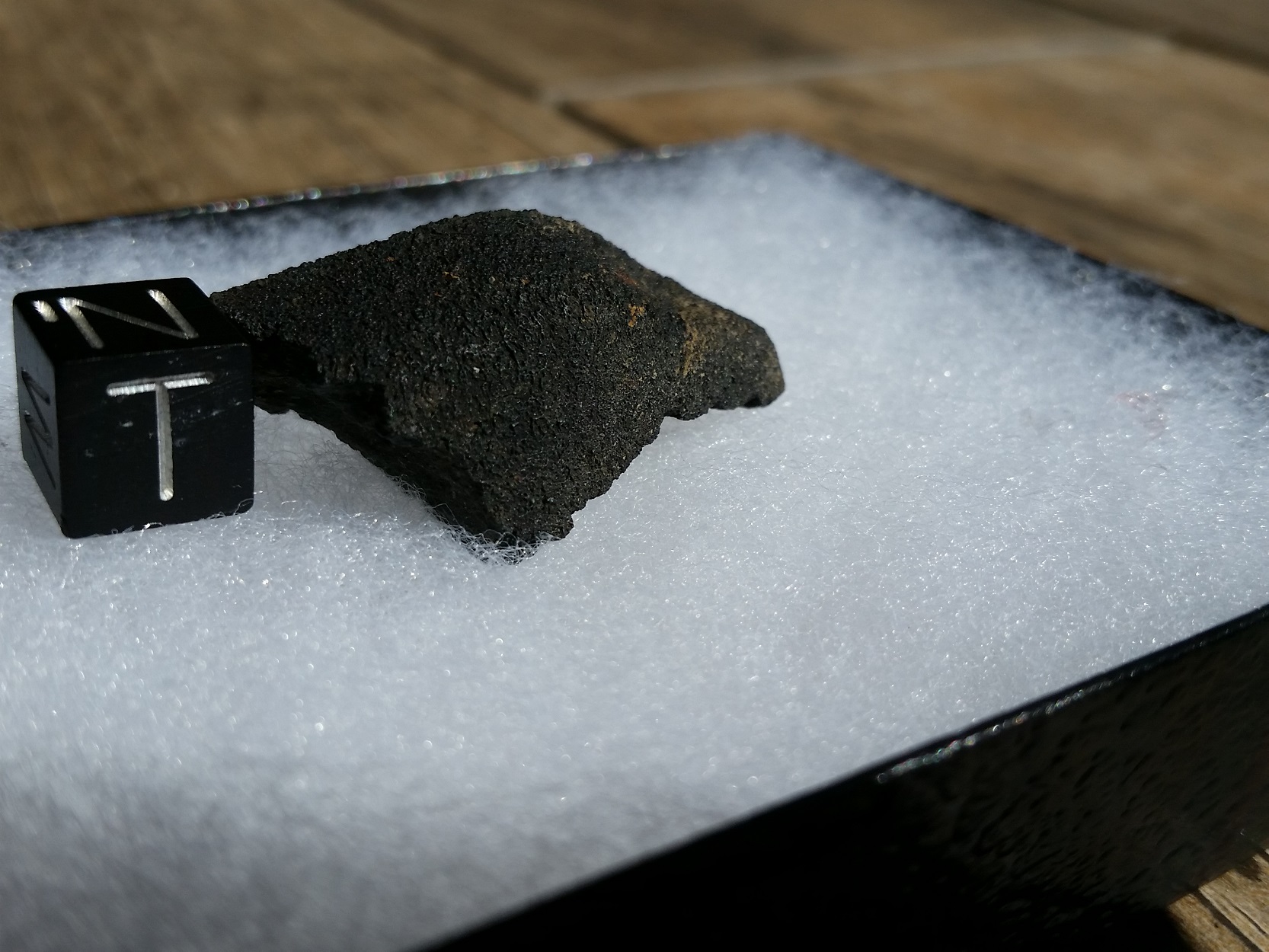
Above is another view of the fusion-crust on my specimen of the Murray (CM2) meteorite.
Here is a compilation of what I found on the Internet about the Murray meteorite:
On September 20, 1950, after a brilliant fireball was seen in the neighboring state of Illinois, the Murray meteoroid exploded at a high altitude and after a number of sonic booms were heard, several pieces of the meteorite were recovered some 15 kilometers east of Murray, Kentucky. The largest recovered fragment (3.4 kg) created a small 15 cm deep crater. Murray is the second (now, 3rd) largest of the 15 (now, 18) recovered CM (Mighei-like) Carbonaceous Chondrite falls (Total Mass - 12.6 kg). Over 400 CM stones have been recovered, but most of them are quite small. The five largest CM meteorites are all witnessed falls. A half-century ago amino acids and other complex organic compounds were found in several extant CM2 meteorites. In the past two decades, interest in CM2 meteorites has quickened as tiny diamonds, corundum and other minerals appear to contain trapped gases which predate the beginnings of the solar nebula.
Murray and other carbonaceous chondrites share similar oxygen isotope ratios and have nearly solar Mg/Si ratios. In addition, the members of the CM chemical group are distinguished by small chondrules and inclusions, abundant fine-grained matrix (~70 vol%), and abundant hydrated minerals. The CM2 type meteorites are further characterized by their Ni-bearing sulfides.
Amino acids found in carbonaceous chondrites may be evidence of microbial biogenic activity. Analysis of this meteorite has identified 17 amino acids, seven (7) of which contain D and L isomers (D and L isomers have the same chemical composition, but different molecular structure). Eleven (11) of these amino acids are not found in terrestrial protein, which implies that they are extraterrestrial. The Murchison meteorite, another carbonaceous chondrite (CM2), which fell in Australia in 1969, also contains amino acids.
Gases in this meteorite are divided into two categories: “solar” or light rare gases (helium and neon) and “primordial” or heavier gases (argon and xenon). Gases in the Murray meteorite are primarily solar and are similar in composition to the solar wind.
Water in the Murray meteorite has a very high deuterium to protium ratio, a ratio similar to that of terrestrial water. This suggests that the water in the meteorite must be extraterrestrial. Analysis of silicon carbide from isotopically anomalous acid residues of the meteorite suggests that the silicon carbide in the Murray meteorite is of interstellar pre-solar origin. Additional analysis of the residues indicates that an amorphous oxide alteration also occurred in the meteorite. Isotopic anomalies for silicon, nitrogen, and carbon indicate that these mineral grains may be circumstellar grains from carbon-rich stars.
Mass Spectrometry isotopic analysis of rhenium and osmium indicates that the Murray meteorite may have been formed from different, earlier precursor materials than iron meteorites formed from. These data also suggest that aqueous leaching may have occurred during the meteorite’s preterrestrial history.
Continuing concerns with Murray and other CM2 meteorites include: (1) Can we determine positively whether the hydrated minerals are preterrestrial? (2) Do exotic inclusions sample other bodies besides a putative CM parent body. (3) Do the minute particles/crystals of graphite, diamond, corundum, silicon carbide etc. tell us about the red giants, novae, and/or supernovae which supplied the heavier elements of the solar nebula.
Below is another view angle of my specimen of the Murray (CM2) meteorite.

Above is another view angle of my specimen of the Murray (CM2) meteorite.
Below is a zoom-in of the above image.

Above is a close-up view of the best carbonaceous chondrite specimen in my collection, the Murray (CM2) meteorite which fell in Kentucky on September 20, 1950.
All this evidence indicates that the Murray meteorite is a very early-forming material, formed in a primordial interstellar nebula of the proto-solar system, before the planets were formed. Thus, the Murray meteorite predates the solar system, and some of its silicon carbide grains are being used to date the Milky Way galaxy.
For early references of Murray in the literature, see Boata (1954), Wiik (1956), Mazor and others (1970), Lawless and others (1971), Bernatowicz and others (1987), Zinner and others (1987), and Walker and Morgan (1989). For more recent studies, see the "References" below.
Post Script: As I mentioned earlier, decent-sized specimens of Murray are not easy to find, but a last minute search of the Internet has turned-up an endcut that is currently available here: " Murray Meteorite"from the collection at the Institute of Meteoritics at the University of New Mexico.
Unfortunately, the photos on that website of that specimen of Murray were taken in poor lighting and are under-exposed. Also, there are no good views of the remarkable fusion-crust.
If there are any updates to the story about this CM2 specimen, they will appear HERE!
This article has been highly abbreviated in time for it to be included in this July publication of Meteorite-Times Magazine.
[1] "Space visitors in Kentucky" -- "Meteorites and meteorite impact sites in Kentucky." Ehmann, W. D., 2000, Kentucky Geological Survey, Ser. 12, Special Publication 1, 53 p.
Entry: #20 -- Murray (Stone), Calloway County (36°36'N, 88°6'W)
"This meteorite fell on September 20, 1950, at 1:35 AM. Stones totaling approximately 28 pounds were eventually recovered near Wildcat Creek, 9 miles east of Murray, Kentucky. The Murray meteorite is unusual because it is very organic and gas rich and one of the largest carbonaceous chondrites classified as “CM2”.
[2] "Kentucky Geological Survey Meteorite Database" -- KGS Meteorite Collection Database -- by Warren H. Anderson, Ethan S. Davis, Richard A. Smath
"The KGS collection is an excellent representative sampling of meteorites derived from our solar system. The collection has more than 230 specimens collected from every continent, including many meteorites found in Kentucky. Several Kentucky meteorites are not represented in the KGS collection, but are on display at major museums around the world, but information about them is included in the KGS database for reference."
Murray "is a very rare meteorite, it contains amino acids not found in terresterial material including rare organic- and gas-rich material, considered solar gases and are thought to predate the formation of our solar system."
External links:
[1] Murray from the Meteoritical Bulletin Database (MBD).
[2] Compositional and Topographical Characterization of Carbonaceous Chondritic Meteorites Moss and Murray Using Micro-Raman Spectroscopy and SEM/EDS -- by:
Stokke, Aaron R., Minnesota State University, Mankato, ProQuest Dissertations Publishing, 2018. 10840468.
"Murray’s inclusions contained forsterite and enstatite, its matrix was comprised of primarily graphitic carbon, and both the inclusions and matrix included unidentified minerals. All of the identified, aforementioned minerals have been found in other carbonaceous meteorites."
[3] MINERALOGICAL AND ELEMENTAL COMPOSITION OF CARBONACEOUS CHONDRITES BY MICRO-RAMAN SPECTROSCOPY AND SEM/EDS. -- by:
A.G. Dall’Asén [1], A.R.Stokke [1],R.Paul [1], R.Kayastha [1], B.C. Bromley [2], and S.J. Kenyon [3].
[1] Department of Physics and Astronomy, Minnesota State University-Mankato, Mankato, MN 56001, USA.
[2] Department of Physics and Astronomy, University of Utah, 115 South 1500 East, Salt Lake City, UT 84112, USA.
[3] Smithsonian Astrophysical Observatory, 60 Garden St, Cambridge, MA 02138, USA.
Introduction:
"Here we present a comparative study of the mineralogical and elemental composition of the chondrules and surrounding matrix of two carbonaceous chondritic meteorites, Moss (CO) and Murray (CM), using low-and high-resolution micro-Raman spectroscopy and SEM/EDS (Scanning Electron Microscopy/Energy Dispersive X-ray Spectroscopy). We examine how these properties vary in different regions of the chondrules and matrix [3], and between these two samples, looking for signatures of the physical processes that drove their formation."
Results and Discussion:
"From the Raman spectroscopy results, more minerals were found in Moss than in Murray. In the case of Murray, only olivine was mainly found in the chondrules, and graphitic carbon in the matrix. A few more minerals were found in both meteoritic samples, but they could not be identified, yet. "
Other Related References:
My previous Bob’s Findings can be found *HERE*
If you have any questions regarding this particular specimen, please contact this author at: bolidechaser at yahoo-dot-com